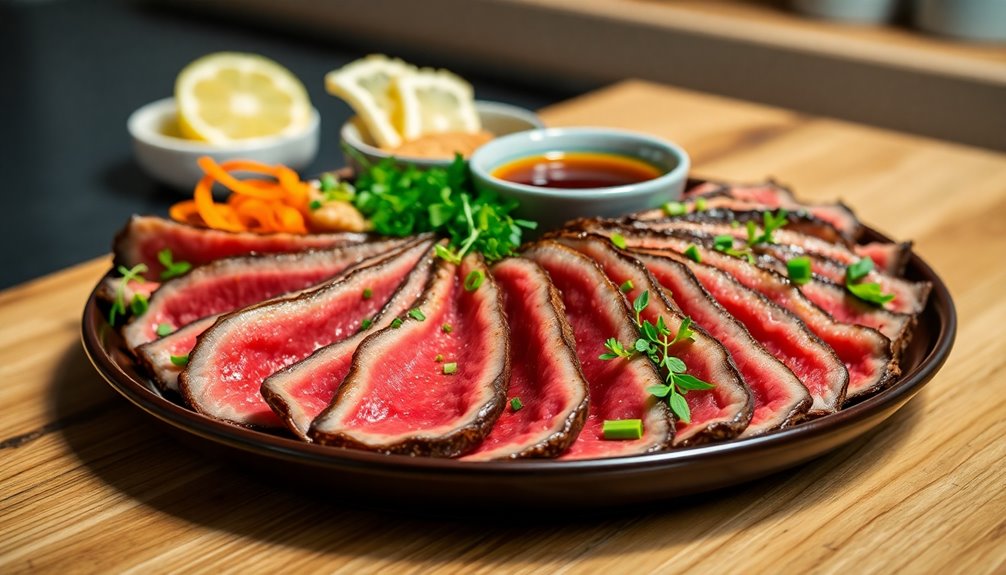Beef tataki is a delightful Japanese dish featuring lightly seared beef that's served cold. This preparation showcases the meat's tender texture and rich flavor, often paired with a zesty ponzu sauce that brightens each bite. It's made from high-quality cuts like tenderloin or sirloin, sliced thinly against the grain for the best experience. This dish not only pleases the palate but also promotes communal dining and sharing. There's so much more to learn about its history and preparation!
History
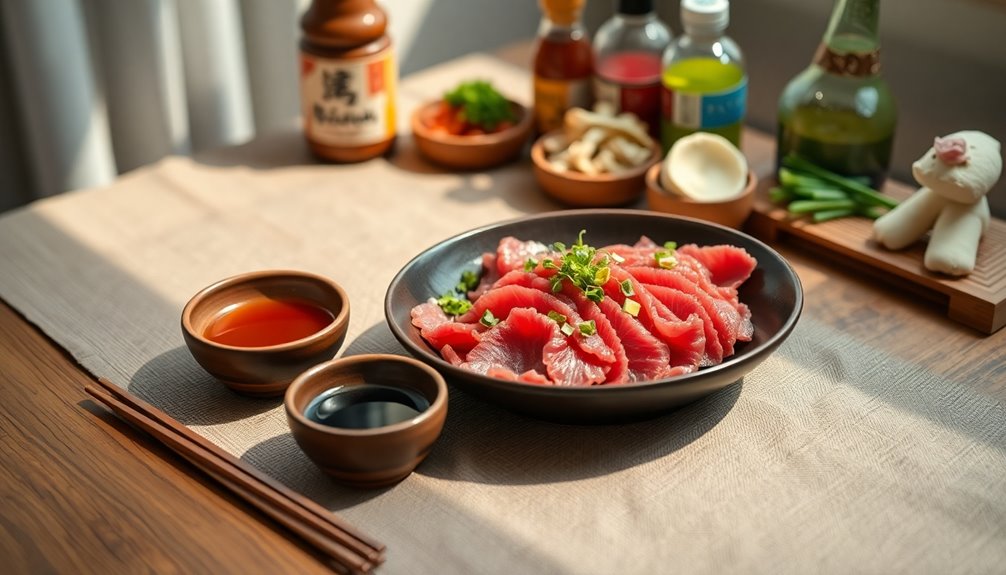
Beef tataki has its roots in Japan, where it was traditionally prepared with lightly seared beef and served cold alongside a zesty ponzu sauce.
The history of this Japanese dish showcases its unique technique of quickly searing the beef, allowing it to maintain a rare center while ensuring safety by killing any bacteria.
The unique technique of quickly searing beef in tataki preserves its rare center while ensuring safety by eliminating bacteria.
The term "tataki" means "pounded" or "hit into pieces," highlighting the method of slicing the seared beef thinly against the grain.
Originally, tataki served as a way to preserve meat, but it has evolved into a beloved delicacy enjoyed worldwide.
Today, you can find beef tataki in high-end restaurants, reflecting the global appreciation for its rich flavors and elegant presentation.
Recipe
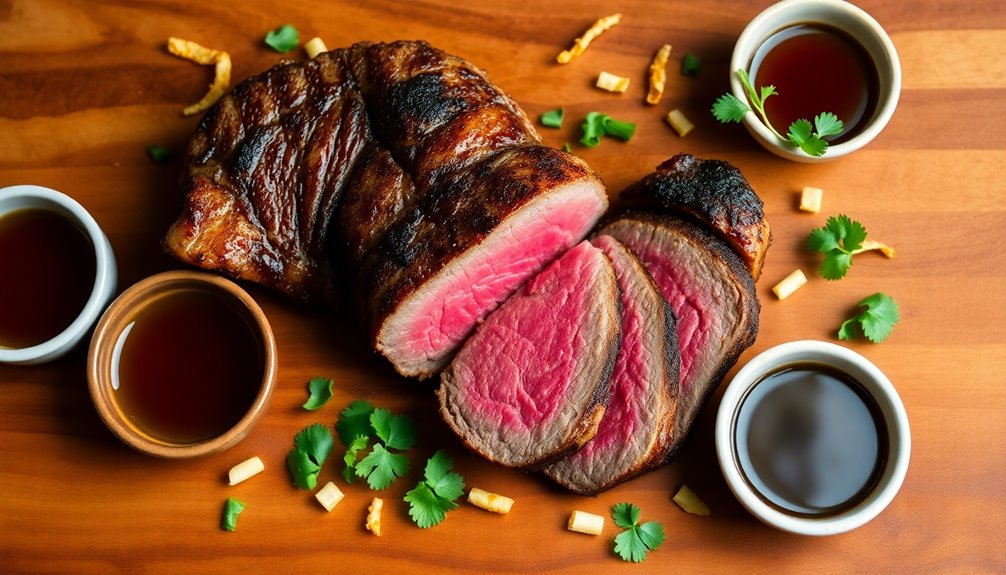
Beef tataki is a delightful Japanese dish that showcases the delicate flavors of high-quality beef through minimal cooking, allowing the natural taste of the meat to shine. The key to a perfect beef tataki lies in using tender cuts such as tenderloin or sirloin, which lend themselves well to quick searing and maintain a juicy, rare center.
The dish is elegantly complemented by a homemade ponzu sauce, which adds a zesty brightness, making it an excellent appetizer for sharing or enjoying on your own.
To prepare beef tataki, start by seasoning the beef generously with salt and pepper. The beef is then seared for just a couple of minutes on each side, enough to create a beautiful crust while keeping the interior rare.
After searing, it's crucial to let the beef rest, which allows the juices to redistribute, resulting in a tender and flavorful bite. When ready, slice the beef thinly against the grain and serve it immediately with the ponzu sauce and your choice of crispy garnishes for texture.
Ingredients:
- 1 lb beef tenderloin or sirloin
- Salt and pepper, to taste
- 1 tablespoon vegetable oil
- ¼ cup soy sauce
- ¼ cup rice vinegar
- ¼ cup citrus juice (like lemon or yuzu)
- Optional: grated ginger and minced garlic for the ponzu
- Crispy garnishes (potato straws, fried shallots, or similar)
Cooking Instructions:
Heat the vegetable oil in a skillet over high heat until it shimmers. Season the beef generously with salt and pepper, then sear it in the hot skillet for about 1-2 minutes on each side until a golden-brown crust forms.
Remove the beef from the skillet and let it rest for at least 10 minutes. Meanwhile, combine the soy sauce, rice vinegar, and citrus juice to create the ponzu sauce, adding ginger and garlic if desired.
Once rested, slice the beef thinly against the grain and arrange it on a platter. Drizzle with the ponzu sauce and sprinkle with your choice of crispy garnishes.
Extra Tips:
For the best results, use high-quality beef that's well-marbled and fresh. If you have the time, consider using the sous vide method to ensure precise cooking and tenderness; cook the beef at 130°F (54°C) for 1-2 hours before searing.
Additionally, serve the dish immediately after slicing to maintain the beef's quality and the crispness of the garnishes. Experiment with different garnishes and variations of ponzu to find your perfect combination!
Cooking Steps
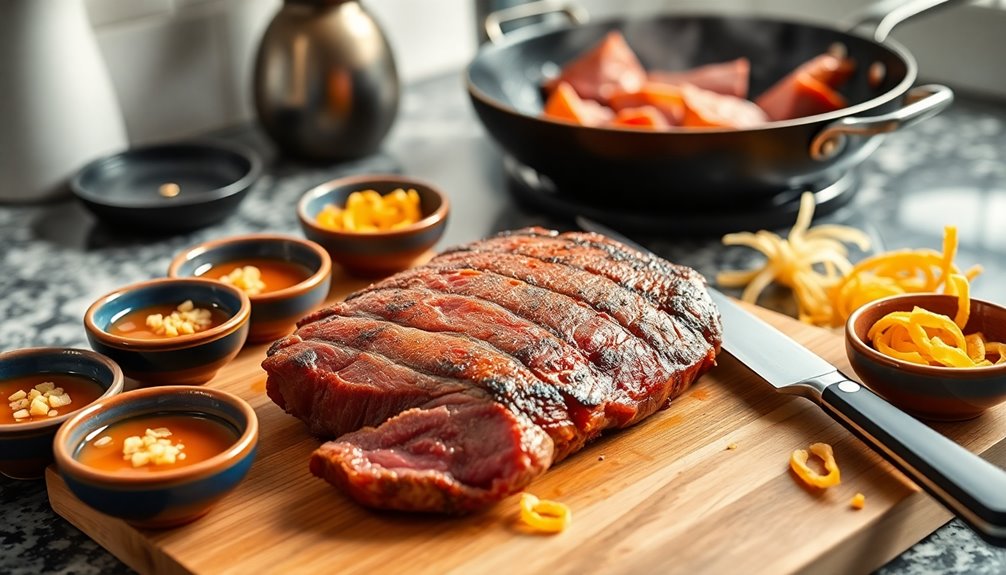
To make delicious beef tataki, start by seasoning your beef fillet and preparing garlic-infused oil for extra flavor.
Grill the beef until it's medium-rare, then slice it against the grain for the best texture.
Finally, add garnishes to elevate the presentation and taste of your dish.
Step 1. Season the Beef Fillet

Seasoning the beef fillet is a crucial step that enhances its flavor and ensures a delicious result. Start by generously seasoning a 300g cut of beef with salt and pepper, then let it rest at room temperature for about 10 minutes. This helps the flavors absorb better.
In a medium-sized frying pan, add a splash of sesame oil to enrich the taste while searing. Sear the beef fillet for one minute on each side to achieve a medium rare doneness, focusing on creating a crust without overcooking the center.
After searing, let the beef rest on a chopping board for 5 minutes, allowing the juices to redistribute. Finally, slice it very thinly against the grain for a tender, melt-in-your-mouth experience.
Step 2. Prepare Garlic-Infused Oil

Infusing oil with garlic is a simple yet flavorful way to elevate your beef tataki.
Start by simmering peeled garlic cloves in a neutral oil, like grapeseed or rapeseed, on low heat for about 5 minutes. This prevents the garlic from burning while allowing the oil to absorb its rich flavor.
After simmering, let the oil sit for an additional 15 minutes to enhance the garlic infusion. Once infused, strain out the garlic cloves to achieve a clear oil.
Drizzle about 1 to 1.5 tablespoons of your garlic-infused oil over the plated beef tataki to enhance its flavor without overwhelming it.
Store any leftovers in an airtight container for up to 3 days to maintain freshness.
Step 3. Grill Until Medium-Rare
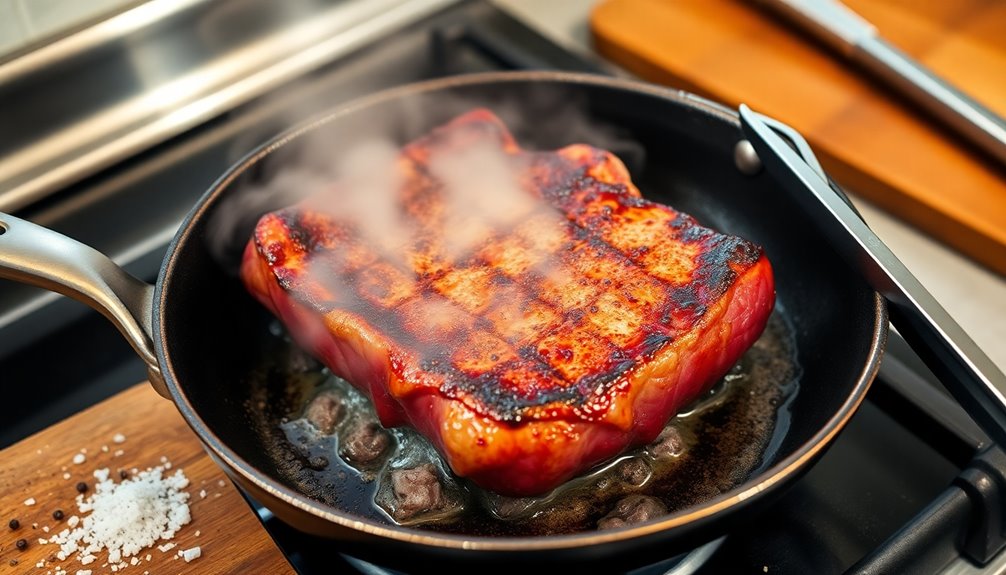
After preparing your garlic-infused oil, it's time to grill the steak for your beef tataki.
Preheat your grill to 500 degrees Fahrenheit and sear the steak for about 2 minutes on each side to develop a nice crust. This initial high heat keeps the center rare while you aim for medium-rare doneness.
Next, move the steak to indirect heat until it reaches an internal temperature of 120-125 degrees Fahrenheit. The time this takes will vary based on the cut's thickness.
Once done, let the grilled steak rest for 10 minutes. This resting period allows the juices to redistribute, ensuring your sliced beef is tender and flavorful.
Remember to use a meat thermometer for accurate results!
Step 4. Add Garnishes for Presentation
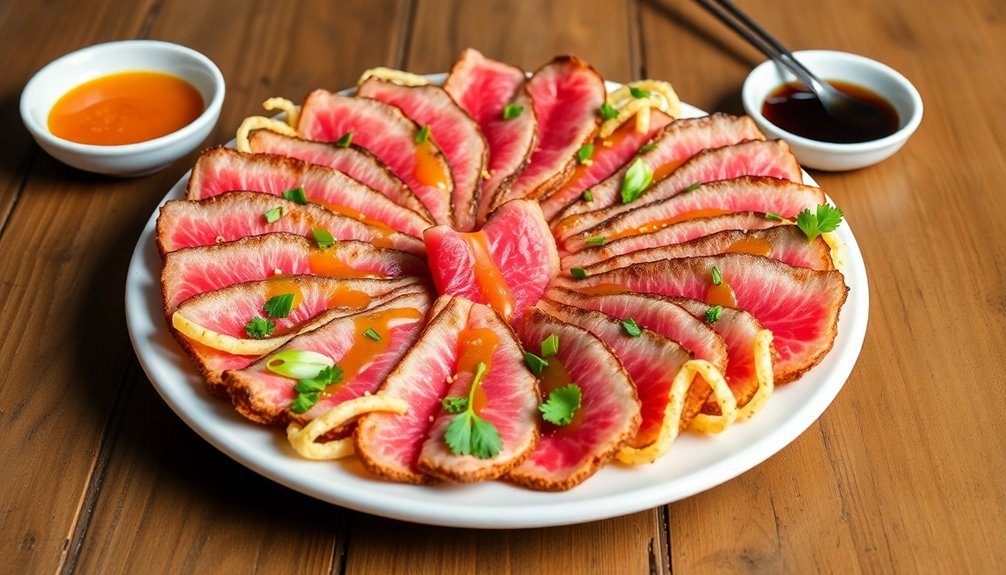
To create an eye-catching presentation for your beef tataki, start by adding garnishes that enhance both flavor and aesthetics.
Pile crispy potato straws in the center of the dish for an appealing contrast in texture. Next, finely slice green onions and sprinkle them over the top to add freshness and a vibrant pop of color.
Drizzle garlic-infused oil over the beef for a glossy finish and an extra layer of flavor. Scatter toasted sesame seeds on top for a delightful crunch that complements the dish.
Finally, consider adding a drizzle of ponzu sauce around the plate. This elegant touch highlights the citrusy notes of the tataki, making your presentation truly stunning and inviting.
Step 5. Slice Beef Against the Grain
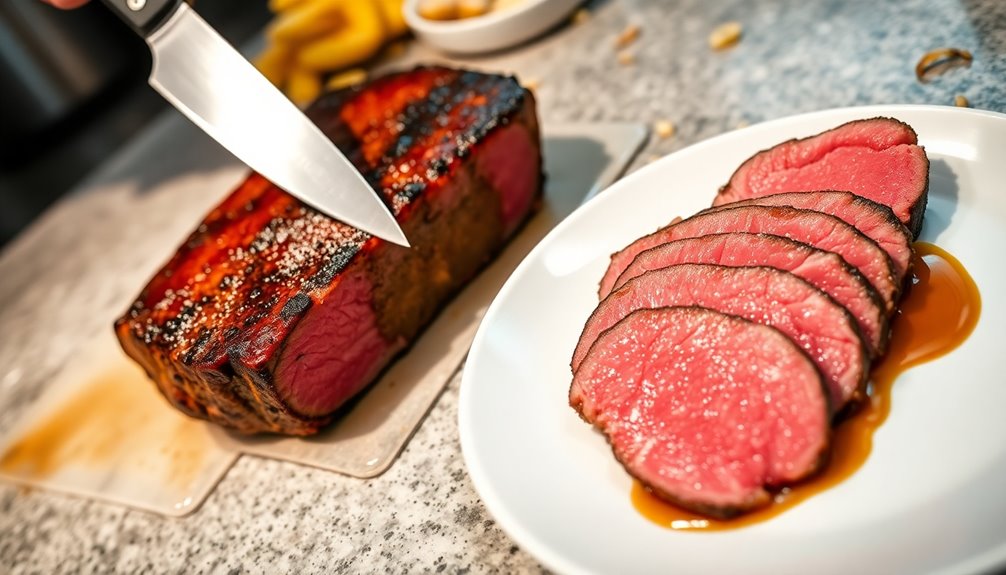
Once your beef tataki garnishes are ready, it's time to focus on slicing the beef for the best texture and presentation.
First, let the seared beef rest for about 5 minutes; this helps redistribute juices and keeps it perfectly rare.
Then, grab a sharp knife, as clean cuts are crucial. Identify the direction of the grain and slice beef against the grain, ensuring tender, easy-to-chew pieces.
Aim for thin slices, around 1/4 inch thick, to enhance both presentation and the penetration of the beefy flavour.
Hold the meat firmly while you slice to prevent tearing.
This technique will elevate your beef tataki, making each bite a delightful experience. Enjoy!
Final Thoughts
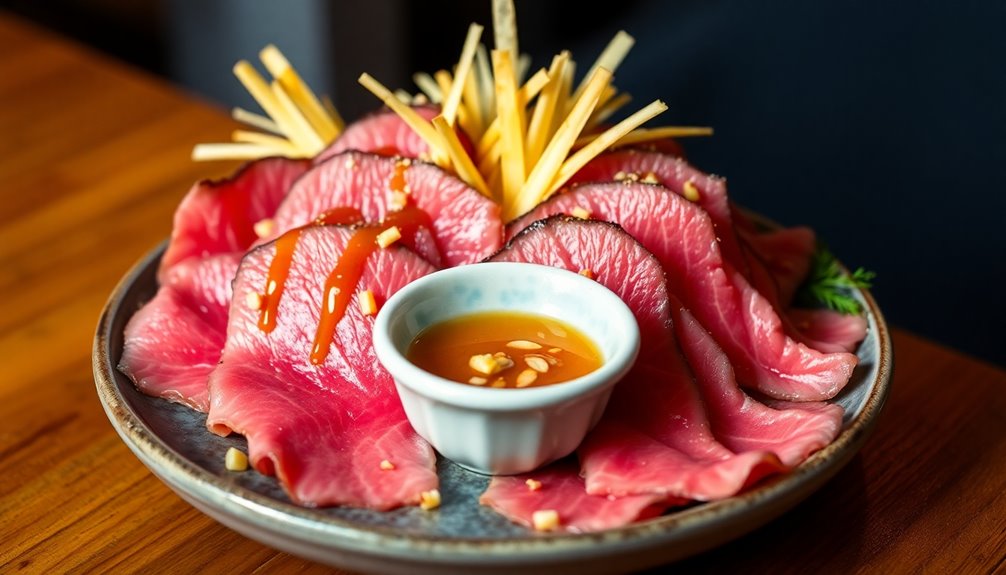
While you can enjoy beef tataki anytime, it truly shines at gatherings where sharing and interaction are the focus. This dish, featuring perfectly seared, rare beef, invites everyone to dive in and savor the flavors together.
The combination of high-quality beef and a zesty dipping sauce like ponzu or soy sauce elevates any meal, making it a standout appetizer. When served at room temperature, the tender slices of beef become even more enjoyable, encouraging guests to take their time and indulge.
Whether you opt for the restaurant-style or the simpler homemade version, beef tataki fosters a warm, communal atmosphere.
Frequently Asked Questions
What Is Beef Tataki?
When you think of a dish that showcases high-quality meat, you're likely considering something that's briefly seared and served rare.
It usually involves a tender cut that melts in your mouth, accompanied by a tangy sauce that elevates the flavors. You might slice it thinly to enhance the experience, garnishing it with crunchy elements for texture.
This dish often finds its place at gatherings, perfect for sharing and enjoying with friends.
Do You Eat Beef Tataki Raw?
You might think eating raw beef sounds risky, but it's all about quality and preparation.
When you enjoy a dish featuring rare beef, you're tasting a unique texture and flavor that's hard to replicate. Of course, it's not for everyone—pregnant women and those with health issues should steer clear.
Just remember, if you're going for it, make sure you've sourced the meat wisely and followed safe handling practices. Enjoy the adventure!
Is Beef Tataki Meant to Be Cold?
Yes, it's meant to be cold! When you serve it chilled or at room temperature, you really enhance the flavors.
The coolness allows the marinade and any accompanying sauces to shine, giving you that refreshing taste experience. While you can enjoy it warm, the traditional cold presentation is what makes it special, highlighting the contrast between the seared exterior and the tender, rare interior.
It's perfect for summer meals or elegant gatherings!
What Is a Tataki?
Tataki is a Japanese cooking technique where you briefly sear a protein, usually fish or beef, to create a dish that has a rare center and a nicely caramelized exterior.
The term 'tataki' means 'pounded' or 'hit in', reflecting the preparation method.
It's often served with a zesty sauce like ponzu, and garnished with ingredients such as scallions and sesame oil, adding flavor and texture to this delightful dish.
